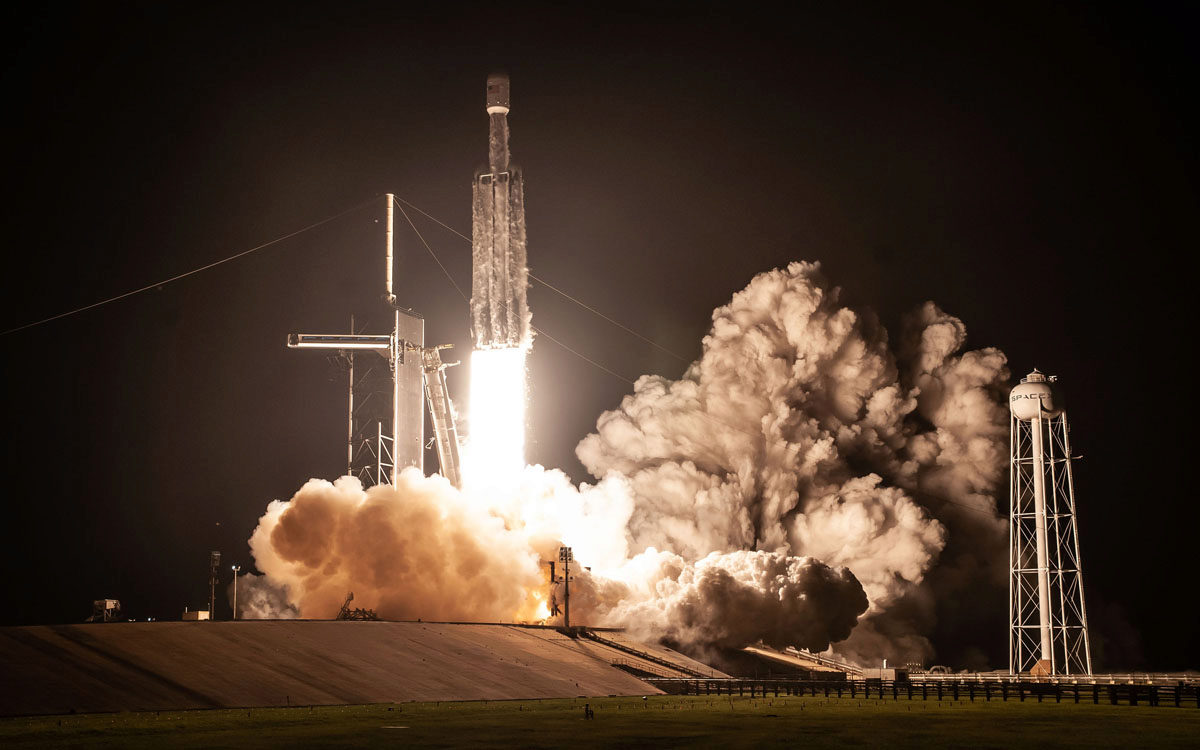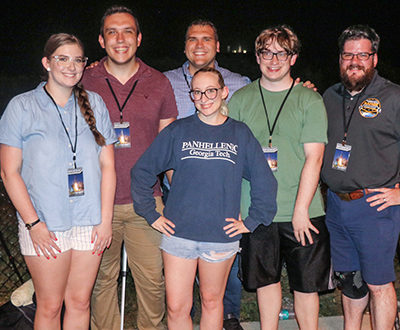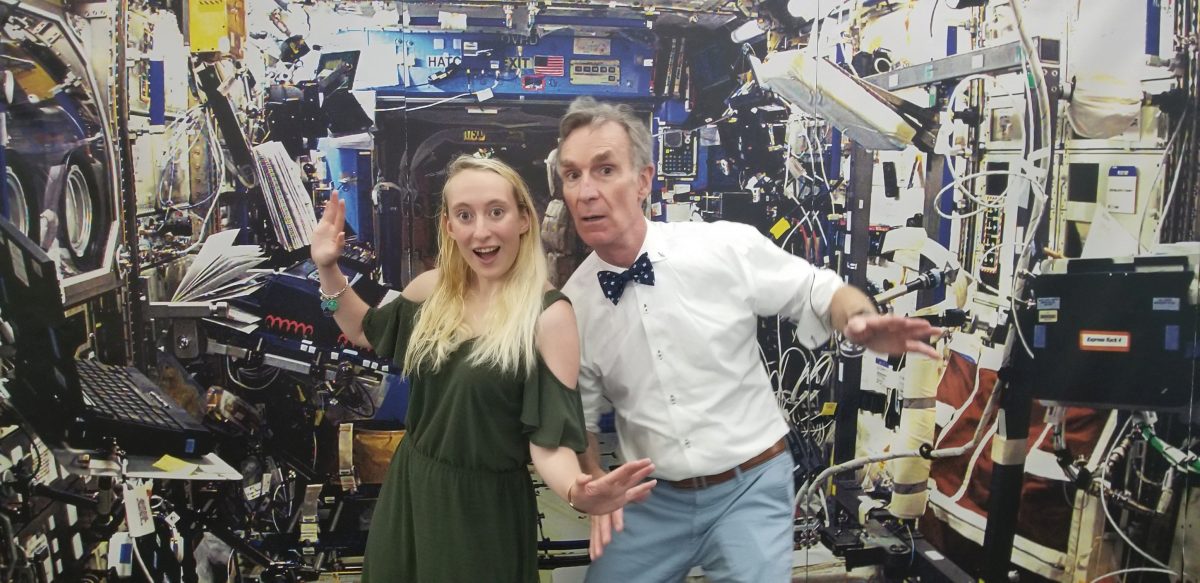
Blast Off! Georgia Tech's Prox-1 satellite was one of 24 satellites that hitched a ride from the SpaceX Falcon Heavy, which launched at around 2:30 a.m. on June 25. View more photos | Watch Prox-1 Launch Photo - and rocket - courtesy of SpaceX.
Years of planning, design, and testing paid off handsomely on June 25, as the Georgia Tech-built Prox-1 satellite was finally launched into space aboard the SpaceX Falcon Heavy rocket.
The 154-pound Prox-1 was one of 24 cubesats that hitched a ride on the Falcon Heavy — the world’s most powerful operational rocket. Once it is deployed from its rideshare, Prox-1 will embark on its own mission: to deploy LightSail-a solar-powered sailing satellite developed by the Planetary Society.
 |
| Worth the Wait. Current and past AE student engineers flocked to Florida to watch Prox-1 get launched on June 24. From left, they are Micah Pledger, Josh Ingersoll, Teresa Spinelli, Kevin Okseniuk, Kyle Scott and Sterling Peet. If you look between the heads of Okseniuk and Scott, you can just barely make out the partially illuminated barrel of the Falcon Heavy rocket, which was just minutes from being launched to space. |
Though the launch was delayed until the wee hours of the morning, Prox-1 was not lacking for a spirited cheering section. Among the throngs of spectators gathered at Kennedy Space Center were Professor E. Glenn Lightsey and former AE professor Dave Spencer, both of whom oversaw the multi-year project that served as a learning venture for hundreds of undergrads and grad students.
"The thrill of seeing our work launched into space never gets old. The number of people who have put hardware into space is a lot smaller than the number who have earned PhDs," said Lightsey, who has worked on dozens of satellites during his career as a NASA engineer and an aerospace engineering faculty.
"With this launch, Georgia Tech is now tracking and managing five spacecraft that are currently in space. It does not surprise me that so many of our students wanted to watch this. It's not just the sense of accomplishment, but, also the sense of pride and closure in a job well-done."
Kevin Okseniuk, BSAE '16, took a break from his doctoral studies at Stanford University to bid the 154-pound satellite adieu.
"Never in my life, growing up, would I have dreamed of attending a school like Georgia Tech -- even less so working on a project of the caliber of Prox-1," he said.
Three hours after Prox-1's 2:30 a.m. launch, Okseniuk was on a plane back to California to continue his research. No regrets about the interruption, though:
"Prox-1 will de-orbit someday, but the lessons learned will stay in my heart forever."
Another Prox-1 architect, Grayson Huggins, BSAE '19, watched the launch from California, where he is currently interning at NASA's Jet Propulsion Laboratory.
 |
| Prof. E. Glenn Lightsey |
“It is really one of my proudest achievements in my life, and it’s something nobody can ever take away from me.Something I built will be in space, and that’s amazing to be able to say at 22 years old.”
Funded by a $220,000 grant from the University Nanosatellite Program, Prox-1 was first conceived more than seven years ago as a project of AE's Space Systems Design Lab. When the finished product was shipped off the Air Force Research Lab for a final inspection two years ago, the 24” by 22” by 12” satellite looked like a metal shop project. But looks can be deceiving. Prox-1 has solar panels that are too delicate to be touched by bare human hands; the actuators, microcomputers, and sensors contained within must also be gently handled and precisely placed to ensure proper functioning.
Prox-1 will spend its first week quietly circling Earth, allowing time for the other spacecraft launched into the same orbit to drift away, so that each can be identified individually. Many eyes will be on Prox-1 because it is carrying an important piece of equipment: a micro-satellite called LightSail.
LightSail is part of a 10-year project sponsored by the Planetary Society, the independent space interest group headed up by engineer and television personality Bill Nye.
 |
| Prox-in-a-Box. Grayson Huggins, BSAE '19, is seen here in 2017 when he and a few dedicated students packed up Prox-1 to be shipped to the Air Force Research Lab in New Mexico, where it was inspected before gaining a payload spot on the Falcon Heavy. Huggins is currently interning with SpaceX. |
Once deployed from Prox-1, LightSail will unfurl a solar sail about the size of a boxing ring and will attempt to become the first spacecraft to be powered using only sunlight. It may take some time to determine how the mission has gone, but plenty of Yellow Jackets witnessed its launch and will keep tabs on its future.
One of them is former Prox 1 mission manager, Teresa Spinelli, a 2017 AE grad who flew in from Washington, D.C, for the launch.
“As a college student, I was so excited to work on something real that would go to space. It felt like everything I had dreamed of was coming true,” said Spinelli, now an engineer at Northrop Grumman Innovation Systems
“While I wish Prox-1 would have been able to launch while I was a student, I’m so excited to see it finally get a chance to fly.”
Spinelli was not alone in her praise. Swapnil Pujari, who worked on the Prox-1 project as an undergrad and a master's student, watched the launch from California, where he is now an engineer at the Boeing Company:
"I'm very proud of what we accomplished and of all the great people I got a chance to work with. We put in lots of hard work over the years and it is finally coming to fruition. It takes a village to make something truly remarkable."
 Space Cadets. AE alumna and Prox-1 contributor Teresa Spinelli got a chance to goof around with Bill Nye the Science Guy when both attended the June 25 launch of the Falcon Heavy rocket in Florida. Spinelli now works with Northrop Grumman while Nye heads up The Planetary Society, whose Lightsail satellite is also being deployed from the Falcon Heavy.
Space Cadets. AE alumna and Prox-1 contributor Teresa Spinelli got a chance to goof around with Bill Nye the Science Guy when both attended the June 25 launch of the Falcon Heavy rocket in Florida. Spinelli now works with Northrop Grumman while Nye heads up The Planetary Society, whose Lightsail satellite is also being deployed from the Falcon Heavy.